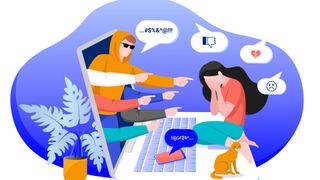Meet the tech empowering women to fight back against cyber harassment
With online harassment soaring, the tech industry is reacting

As our lives become more and more digitalized, so do our risks.
The internet and social media are a dangerous double-edged sword. On the plus side, they allow everyone to raise up their voice - especially powerful for minority groups. But, their liberal and open nature make cyber harassment very easy to spread and difficult to manage. And, similar to real world violence, women are the ones paying the highest price.
Female figures in the public eye, like journalists and activists, are the preferred targets. And there's no sign of it stopping anytime soon - indeed, it seems to be getting worse.
With victims seeking digital solutions, the tech industry is reacting. VPNs and specialized software can indeed make a huge difference in the battle against cyber harassment.
In this article, we're looking at the current state of online harassment against women and how digital technologies can help to tackle the issue in practice.
Cyber harassment and emerging solutions
As the latest statistics show, the pandemic has intensified the worrying trend of cyber harassments against women - it's been exacerbated by the fact that women spend more time online.
“You’re crying in front of your laptop, and you know what I want? I would like to get access to resources, external resources, third parties or [online] resources. Or advice like a security checkup to protect yourself better," said one of the female journalists who took part in a research study carried out by Google technology incubator Jigsaw.
Are you a pro? Subscribe to our newsletter
Sign up to the TechRadar Pro newsletter to get all the top news, opinion, features and guidance your business needs to succeed!
Following their study, Jigsaw released the open sourcing of Harassment Manager. This is a web application built to help women to manage online abuses and collect the necessary evidence needed in case of legal actions. We discuss the Harassment Manager tool in more details below.
Also other software is being released to rise up to the challenge (although with limitations). Take Squadbox, for example - developed by the Haystack Group at MIT Science and Artificial Intelligence Lab, it's a tool focused on content moderation to address targets' emotional and safety needs. BlockParty allows victims to set Twitter filters to limit and control their exposure to abusive content. While Unmochon is handy for capturing authenticated screenshots on Facebook.
VPN providers are also trying to educate their users about the matter. In this regard, PureVPN has launched a campaign to raise awareness about cyberstalking - again, we have more on this further down the article.
Cyber harassment against women is growing
Over the last years, statistics have shown a surge in electronic violence against women. As the Covid-19 pandemic meant relying more on Web resources, these threats have consequently intensified.
According to a 2020 study carried on by Jigsaw in partnership with The Economist Intelligence Unit (EIU), around 40% of women surveyed had been harassed online. At the same time, the majority (85%) had witnessed some form of online violence.
Two years before, the International Women’s Media Foundation (IWMF) report showed that more than 60% of women journalists had suffered cyber violence. In some instances (26%) these attacks moved from the online to the offline world.
We decided to focus on documentation and reporting needs in particular because unless some tangible artifact exists as evidence - it is incredibly hard to provide support or fix the problem.
Google Jigsaw
Cyber harassment hugely impacts women, on their mental health as well as their work. Online attacks could then result in a chilling effect over news gathering and freedom of expression around the world, intensifying gender-based divisions.
Nearly nine in 10 women restrict their online activity, the EIU found out. According to IMF data, almost 40% of women journalists renounced to cover certain stories with a third of respondents saying to have thought of quitting the profession after experiencing online abuses.
What are the types of online abuse?
Cyber harassment can be seen as one of the most invasive and traumatic forms of online violence. Offenders take on victims - especially on social media platforms - by insulting, attacking and threatening them over and over. In some instances, they resort to malware for stealing their targets' sensitive data. In the worst cases, violence can actually escalate from the online to the real world.
In cyberspace violence then comes in different shapes, bringing diverse and personalized risks:
- Trolling: Trolls harass and intimidate victims through a never-ending stream of hateful comments. Even some governments across the world are known to finance keyboard armies for spreading propaganda and interfere in political decision-making.
- Online sexual harassment: Sexual predators operate across dating apps, forums and social media platforms to harass victims with abusive comments and intimate pictures. This could generally escalate in something more serious, like cyberstalking.
- Cyberstalking: Cyberstalkers can undermine victims' safety in different ways. Targets can have their movements tracked through their phone GPS. Offenders may install malware to steal sensitive data or create fake accounts to impersonate victims online.
- Doxing: Hackers infiltrate victims' devices to collect personal data for then publishing those online. The goal is to undermine targets' sense of security, causing panic or self-censorship.
- Swatting: This criminal activity is an example of when online abuses become real also offline. Criminals spread false reports to trick emergency services into sending authorities to a person’s address.

Limitations of existing reporting tools
Cyber harassment may be a growing issue spreading across social media platforms, but the truth is that these spaces struggle to control and manage online abuses.
If some existing solutions like Squadbox, BlockParty and even Jigsaw’s Perspective (a free tool that uses machine learning to spot toxic language) help victims to cope with the mental stress caused by online violence, these are not enabling targets to efficiently report crimes when they occur.
As EIU findings pointed out, only a quarter of women generally flag the behavior to the platform. At the same time, just 14% of respondents denounced abuses to an offline protective agency.
That's mainly because reporting violence is extremely time-consuming, often it's even impossible to keep up with it. Tracking hateful comments down can also have a negative impact on users' wellbeing. Plus, screenshots are not always valid evidence to build up a legal case in court.
How Harassment Manager can help
After carefully listening to the needs of women journalists and activists, Jigsaw - a unit within Google that explores threats to open societies for building tech solutions - developed Harassment Manager to empower victims to document and take action against online abuses received on social media.
This #IWD2022, we're excited to announce the open sourcing of Harassment Manager, a web application built to help women public figures to manage toxic language directed at them online, in partnership with @Twitter & @TRF. #EndOnlineHarassment🧵 ⤵️ https://t.co/GQ1aBbmqe2 pic.twitter.com/Ugtb3Sb4i1March 8, 2022
As Jigsaw explained in its research study: "We decided to focus on documentation and reporting needs in particular because unless some tangible artifact exists as evidence - it is incredibly hard to provide support or fix the problem."
Harassment Manager helps users to easily identify harmful posts, mute or block perpetrators of harassment as well as hide abusive replies to their own tweets. Individuals can review tweets based on hashtag, username, keyword or date. It combines Jigsaw's Perspective API to detect comments that are most likely to be toxic.
The tool open-sourcing is now on GitHub for developers and non-governmental organizations to build and adapt for free according to their own needs.
Among the organizations that took part in the project are Twitter, Article 19, International Center for Journalists (ICFJ), Online SOS, PEN America and even The Thomson Reuters Foundation.
What VPNs can do to help against cyber harassment
As we have seen, the tech industry is getting more and more involved in the fight against cyber harassment. And if some organizations are committed to developing specialized counter-violence software, others feel the duty to educate potential victims on how to mitigate these risks.
In fact, even though the online world can often be harmful, the vast majority of women (83%) who took part in the EIU study see the internet as a helpful source of information and support when dealing with online abuse.
Under this light, the provider PureVPN launched a campaign to raise awareness on cyberstalking while empowering possible targets with a set of resources to help them to be safer when online.
"We hope to be a voice for those whose concerns are, by law, ignored or dismissed, as well as be a guiding light for those who are in danger. We hope we can educate more people on how to protect themselves against online dangers and play our part in the larger movement against online violence," PureVPN said.
#Women are experiencing an increase in online incidents where they are being harassed, bullied, or becoming victims of cyber-attacks of some kind. This #InternationalWomensDay2022 we are here to share how you can stay safe online ⬇️https://t.co/ThmMp9qbvk#IWD2022 #Womensday pic.twitter.com/sIBIHcKyHAMarch 6, 2022
Using a VPN can protect users from several cyber threats, preventing cyber harassment from becoming a real-danger into victims' offline life too.
By masking your IP address and hiding your location, a VPN makes it impossible to track down your movements. It also shields your data from snoopers and hackers into encrypted tunnels. Plus, when you are using a VPN it is much more difficult remotely planting malware on your devices.
Features like Split Tunneling, Port Forwarding and DDoS Protection are particularly effective to guard users from harassers even further.
Despite this, PureVPN is calling for greater transparency and accountability across the entire technology sector. They said: "If VPNs are a solution to censorship and denial of the right to information, they are also in some isolated cases misused for nefarious purposes. What can we do to make sure our technology does not end up in the wrong hands? And if it does, what can we do to protect users? These are the questions we’re constantly confronting and finding solutions for.
"Tech companies need to play their part in also creating awareness and giving back to the community on whose shoulders they are built upon. Additionally, they need to acknowledge their hand in the rise of such threats."

Chiara is a multimedia journalist committed to covering stories to help promote the rights and denounce the abuses of the digital side of life—wherever cybersecurity, markets and politics tangle up. She mainly writes news, interviews and analysis on data privacy, online censorship, digital rights, cybercrime, and security software, with a special focus on VPNs, for TechRadar Pro, TechRadar and Tom’s Guide. Got a story, tip-off or something tech-interesting to say? Reach out to chiara.castro@futurenet.com
Most Popular


